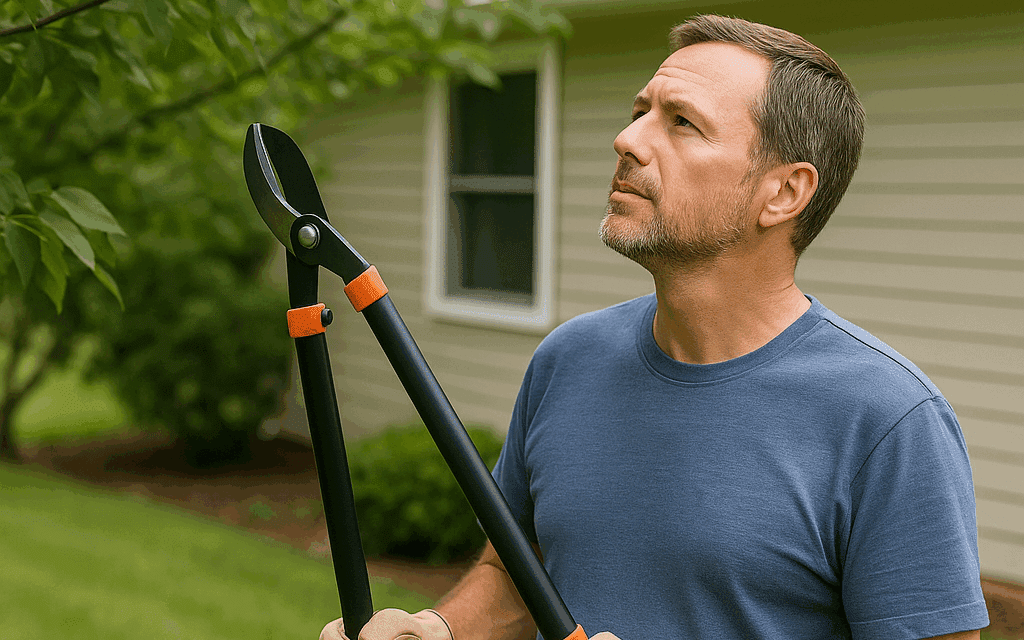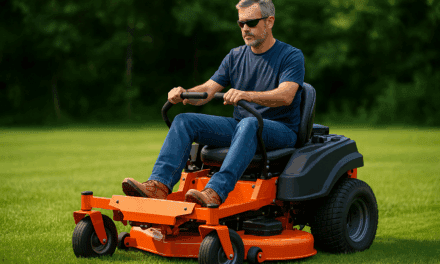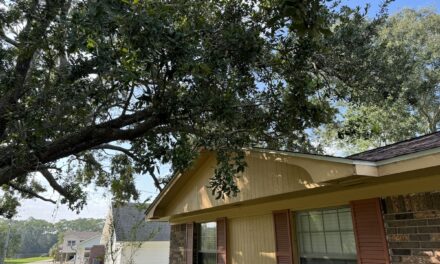Last updated on December 8th, 2025 at 08:54 am
Keeping your trees and big shrubs properly trimmed is essential, not just for curb appeal but for protecting your home and ensuring healthier trees. Overgrown tree branches that hang over your roof or scrape against siding can lead to costly damage, especially during storms. Removing dead branches, shaping young trees, or pruning fruit trees and hedge shrubs at the best time of year (like late winter or early spring) can dramatically improve your landscape’s health and safety.
Be sure to read our popular article “Trim your trees now or lose homeowners insurance coverage”.
In this guide, we’ll walk you through exactly how to trim your trees and shrubs step-by-step. You’ll learn which pruning tools are best for different jobs—whether that means hand pruners for small branches, bypass loppers for larger branches, or a pole saw or extendable tree pruner to reach those high branches. We’ll also cover how to make clean cuts, reduce damage to plant tissue, and safely handle tricky spots near power lines.
With side-by-side graphics showing different tools—from ratchet pruners and pruning shears to electric hedge trimmers, grass shears, and pruning saws—you’ll get a clear look at the right tools for each task. We’ll also spotlight recommended brands known for high-quality tools, sharp blades, ergonomic design, and easy storage.
Whether you’re a DIYer or prefer the help of tree experts, having the best tool for each job goes a long way toward better results and fewer headaches. Let’s get started with everything you need to know to trim trees like a pro.
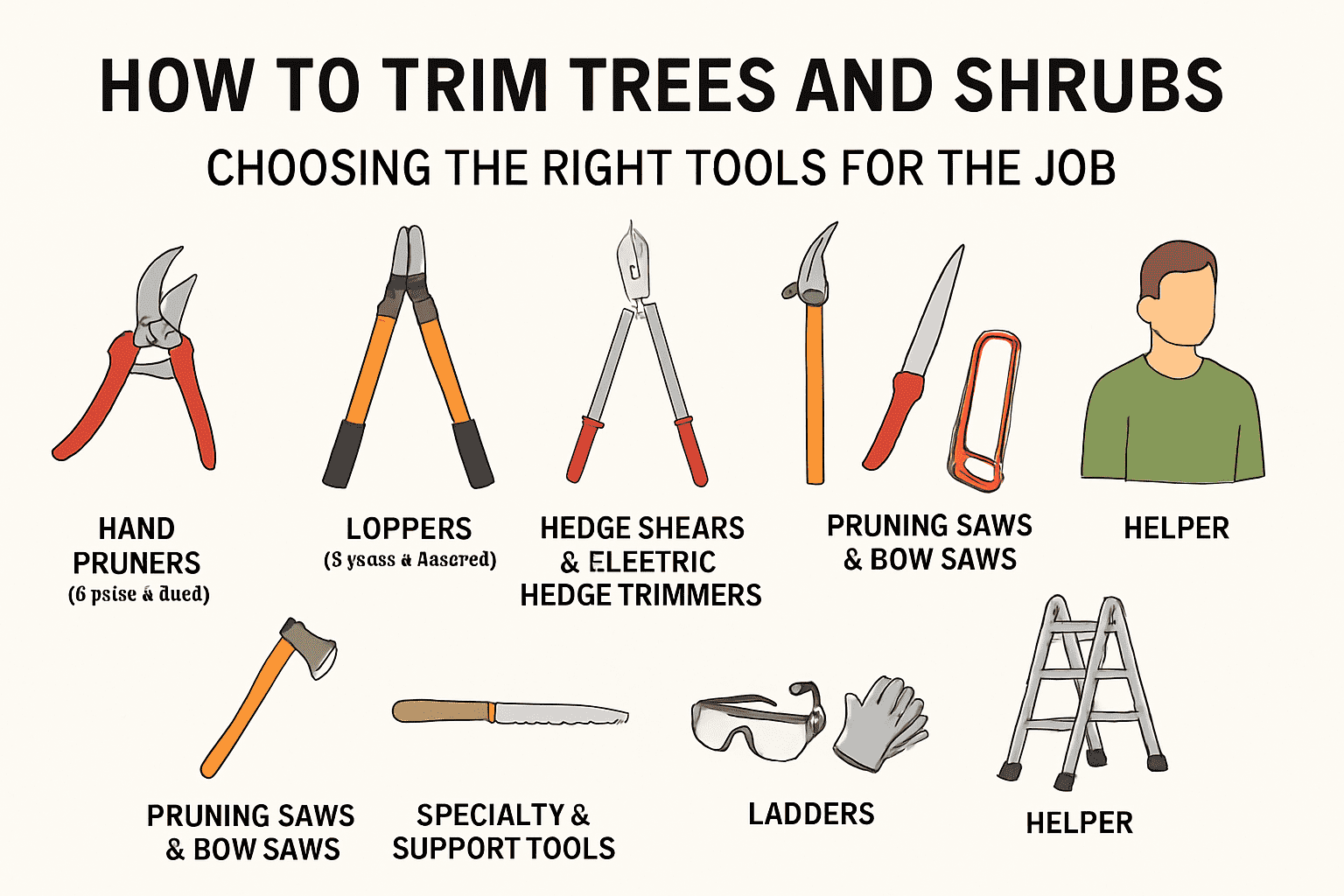
How to Trim Trees and Shrubs: Choosing the Right Tools for the Job
Before making your first cut, you’ll need to match the cutting tool to the type and size of the branches you’re dealing with. Using the proper tools ensures cleaner cuts, promotes healthier tree growth, and minimizes strain on you and the plant.
🔧 1. Hand Pruners (Bypass & Anvil)
- Best for: Small branches, young trees, and dead wood under ¾ inch thick
- Bypass pruners: Make clean cuts using two curved blades (like scissors). Ideal for live stems and precise cuts.
- Anvil pruners: Use a straight cutting blade against a flat surface. Better for cutting dry or dead branches.
- Pro Tip: Look for stainless steel blades, ratchet styles for added strength, and ergonomic design for comfort.
✂️ 2. Loppers (Bypass & Ratchet)
- Best for: Larger branches (up to 1.5–2 inches thick)
- Feature longer handles for greater leverage and extra reach
- Choose ratchet loppers for thick or tough wood
- Excellent for trimming fruit trees, nut trees, and heavy shrub growth
🌿 3. Hedge Shears & Electric Hedge Trimmers
- Best for: Formal hedges and light shaping
- Manual hedge shears work great for touch-ups
- Electric hedge trimmers or cordless pruners save time on larger hedge shrubs
- Use with caution around power lines
🌲 4. Pole Pruners, Pole Saws & Extendable Tools
- Best for: High branches and tall trees
- Tools include long poles (fiberglass preferred), folding saws, or electric pole pruners
- Great for reaching without a ladder
- Ideal for hard-to-reach areas and trimming the main stem or canopy edges
🪓 5. Pruning Saws & Bow Saws
- Best for: Branches too thick for loppers
- Use coarse teeth for pull strokes that reduce effort and tearing
- Good for apple trees, large limbs, and thick, diseased branches
🧰 6. Specialty & Support Tools
- Pruning shears in different sizes for precision work
- Grass shears for low growth or turf cleanup
- Topiary shears for shaping ornamentals
- Safety goggles and gloves for protection
- Weed whackers for clearing the base before tree trimming
🪜 7. Ladders for Safe Access
- Best for: Reaching medium-height tree branches and roofline-level shrubs
- An essential support tool when pole saws or extendable tree pruners aren’t enough
- Use an A-frame ladder with wide footing and slip-resistant steps
- Models like the Little Giant Ladder offer versatility—open flat for wide stance stability or lean securely against a tree trunk or house siding
- Always wear safety goggles and follow proper ladder safety protocol, especially when working around power lines
🧑🤝🧑 8. A Trustworthy Helper
- Best for: Anytime you’re using a ladder—especially a non-A-frame ladder or leaning ladder
- A second person can hold the ladder steady, pass tools, and act as a spotter
- Essential when trimming high branches, using heavy equipment, or working near power lines
- Reduces risk of accidents, saves time retrieving tools, and adds an extra layer of safety when working with sharp or powered cutting tools
🦺 Safety Equipment
Best for: Every task, every time
Before you start, be sure to wear work gloves—choose a pair that allows finger control for using trigger-based tools. Protect your eyes with safety glasses, and wear a long-sleeved shirt and durable work pants to guard against scratches and debris. If you’re operating loud tools like a chainsaw or gas-powered trimmer, use hearing protection to reduce the risk of hearing damage.
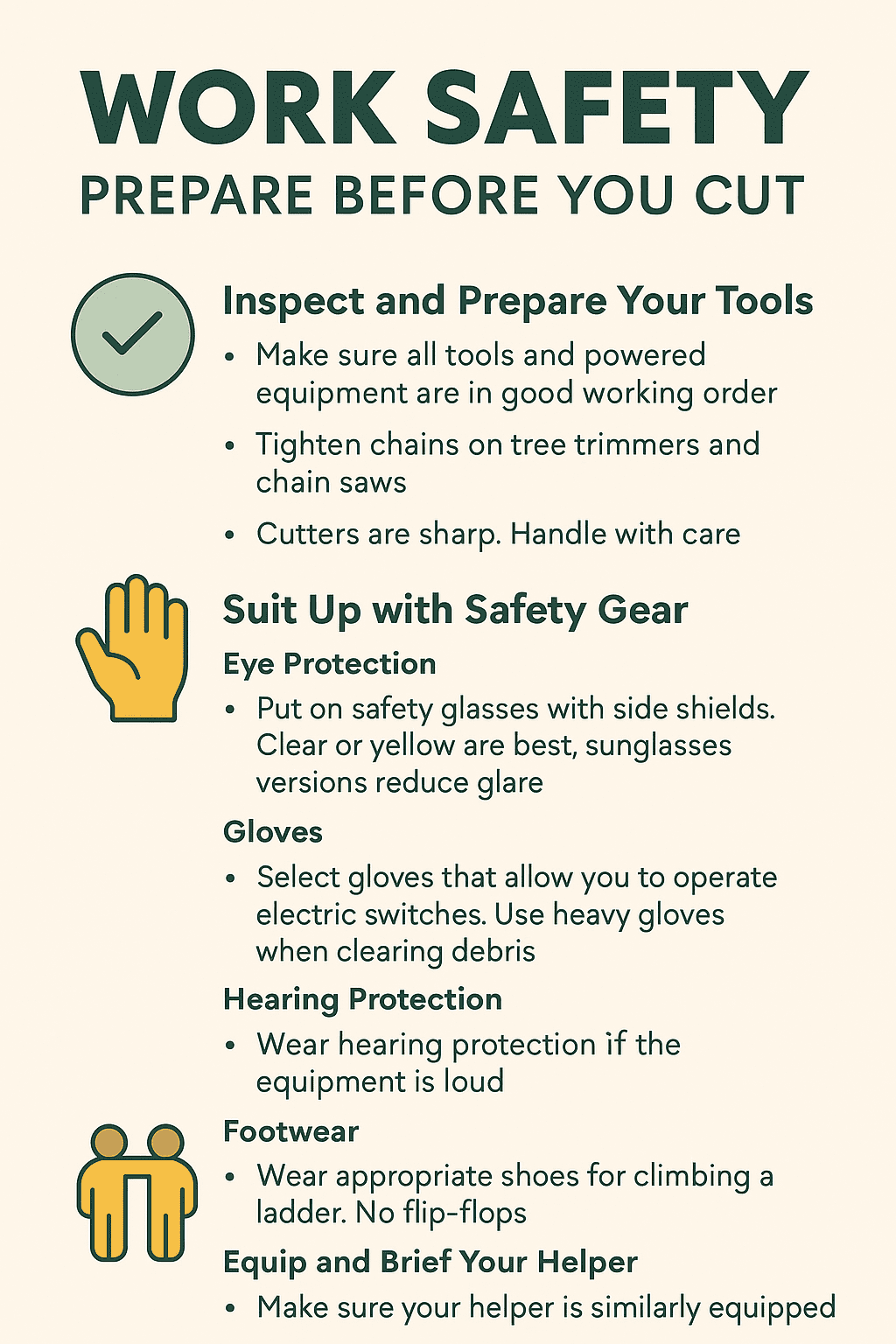
Work Safety: Prepare Before You Cut
Before you start trimming trees or shrubs, take a few moments to plan for safety. Proper preparation can prevent injuries and ensure a smoother, more efficient job.
✅ Inspect and Prepare Your Tools
- Make sure all your garden tools, cutting tools, and powered equipment are in good working order.
- Check for loose parts or worn blades.
- Tighten chains on tree trimmers and chainsaws to prevent dangerous kickbacks or malfunctions.
- Remember: the sharper the blade, the cleaner the cut—but also the higher the risk. Always handle with care.
🧤 Suit Up with Safety Gear
- Eye Protection: Wear safety glasses with side shields to block flying debris from the top or sides. Clear or yellow lenses provide visibility, while sunglass-style options help reduce glare on bright days.
- Gloves: Choose work gloves that allow full control over electric switches and trigger tools. For clearing thorny debris, switch to heavier-duty gloves to avoid punctures from stickers or sharp stems.
- Hearing Protection: Many gas-powered tools, including tree trimmers and chainsaws, operate at decibel levels that can damage your hearing. Use earmuffs or earplugs rated for high noise levels.
- Footwear: Wear sturdy shoes with slip-resistant soles—no flip-flops or open-toed shoes when climbing ladders or handling tools.
🧑🤝🧑 Equip and Brief Your Helper
- Make sure your helper is wearing the same level of protection—gloves, glasses, hearing protection, and proper shoes.
- Explain their role: watching for falling limbs, stabilizing ladders, and passing tools safely.
- A helper should always stay alert and keep a safe distance when cutting begins.
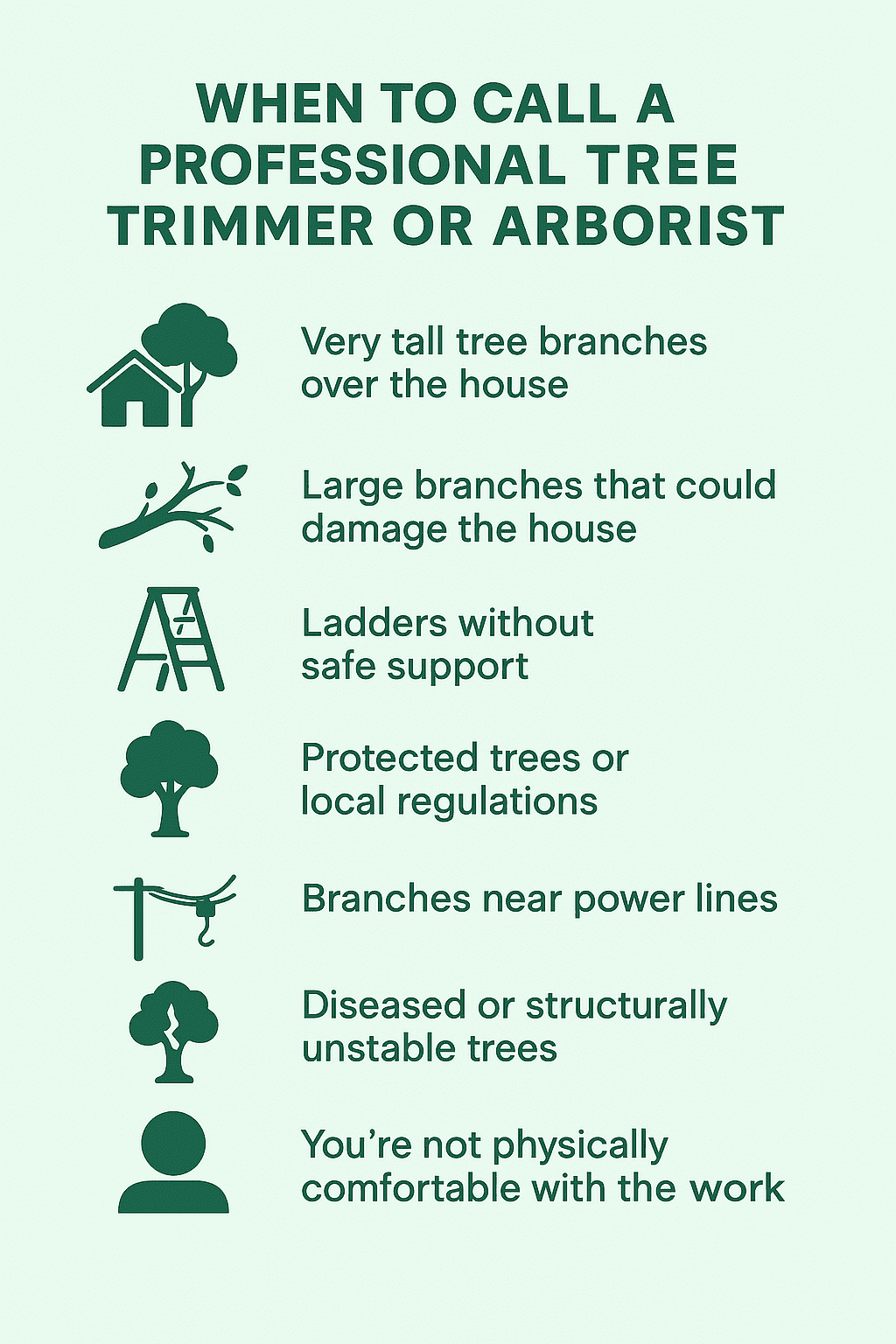
🌳 When to Call a Professional Tree Trimmer or Arborist
Before you start cutting, evaluate whether the job is safe to tackle yourself. In many situations, hiring a certified arborist licensed tree expert, is the right move for your safety, your property, and your neighborly relationships.
1. Very Tall Trees or Branches Over the Roof
Branches that extend far above your house or beyond your ladder’s reach pose serious risks. Professionals have the tools and training to handle high cuts safely.
2. Large Branches that Could Damage the House
Cutting large limbs without proper technique or gear can result in major damage. Arborists know how to rope and lower heavy branches with control.
3. Ladders Without Safe Support
If you’ll be working at the top of a ladder with no stable footing or helper, the risk of injury is too high. Let an expert handle it.
4. Protected Trees or Local Regulations
Certain species may be protected under city or HOA guidelines. Certified arborists can handle the required permits and follow the rules.
5. Branches Near Power Lines
Never trim near overhead electrical wires yourself. Contact the utility company or a professional trained for line-clearance work.
6. Diseased or Structurally Unstable Trees
Rotting or pest-infested trees may be unpredictable. A pro can assess stability and prevent dangerous outcomes during pruning or removal.
7. You’re Not Physically Comfortable with the Work
If you’re unsure, lack the right equipment, or just don’t feel confident—don’t risk it. There’s no shame in outsourcing for safety.
8. Protected Trees Originate on a Neighbor’s Property
When branches cross from a neighbor’s tree into your yard, it’s best to talk with them first. Hiring a professional can ease tension, ensure proper care, and may offer a chance to split the cost.
9. Trees Are Leaning on Fences or Structures
If a tree or branch is resting on a fence or shed, cutting it incorrectly could cause a collapse or further damage. A professional can secure or remove it safely. See our section “How to Spot a Structurally Unstable Tree” at the end of this article.
10. You Have a Large Quantity of Branches to Cut and Remove
Massive pruning projects generate debris. If you’re facing hours of cutting, bundling, and hauling—it might be more efficient (and less back-breaking) to call in the pros.
11. You Need Stumps Removed or Ground Down
Stump grinding requires specialized, heavy-duty machinery. For complete removal or clean landscape restoration, bring in a stump removal service or a full-service arborist.
🛍️ Coming Up Next:
We’ll show graphics of each tool to help you decide the best tool for your type of work—from maintaining formal hedges to pruning dead wood from mature trees.
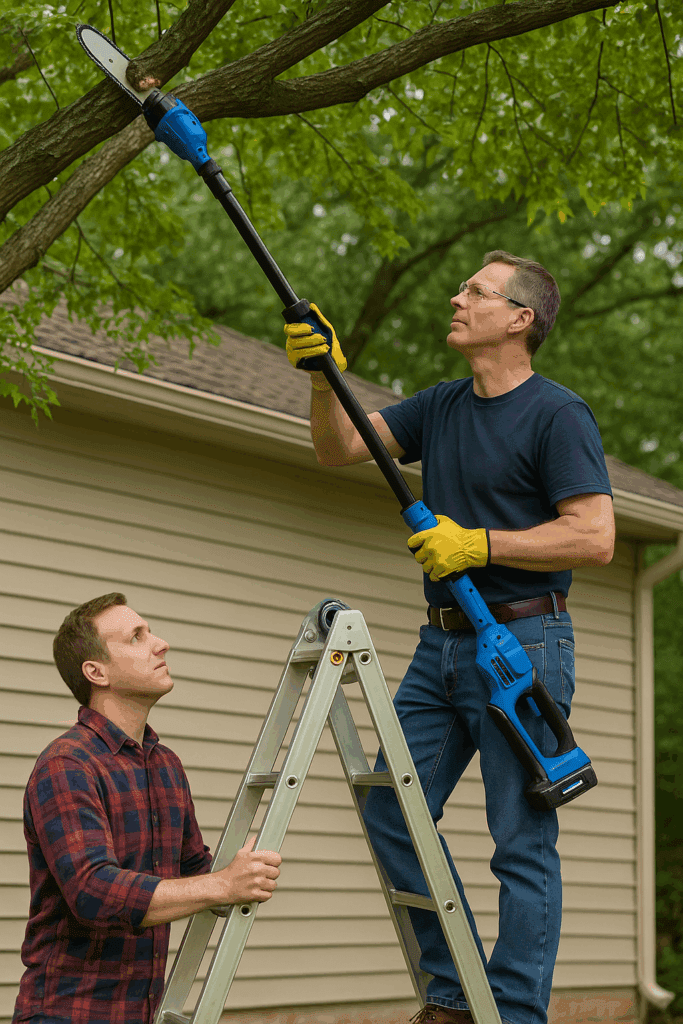
🔋 Recommended Battery-Powered Tools for Tree Trimming
The following tools have been used by the author. There are other brands available.
🌲 Battery-Operated Pole Saw: Ideal for High, Thick Branches
One of the best tools for trimming larger branches—especially those too thick for standard loppers—is a battery-operated pole saw. These powerful, easy-to-use tools are excellent for DIYers and come in many brands with removable extension sections to help you reach high branches safely from the ground.
I personally use the Kobalt 80-volt 10″ pole saw from Lowe’s. While the 80V battery is slightly heavier than the 40V version, it offers noticeably more power and extended run time—perfect for tackling thick branches. You can purchase the saw on its own or bundled with the battery and charger.
This model includes multiple pole segments, letting you extend the reach as needed. Just fill the chain oil reservoir, adjust the tension periodically, and you’re ready to go. It’s straightforward to operate and makes fast work of most backyard pruning tasks.
Pro Tip: Stick to one battery platform when buying power tools. If you mix brands, you’ll end up with a cluttered workbench full of incompatible battery chargers.
🌳 Battery-Operated Chain Saw: Quiet, Efficient Power
Another must-have is the Kobalt 80-volt 18″ battery-operated chainsaw. I added this to my toolkit to match my existing 80V battery—and it’s been a great investment. Unlike gas-powered saws, battery chainsaws produce far less noise (though I still wear hearing protection for safety).
This saw is powerful enough to cut branches larger than 18 inches in diameter. With careful technique—cutting from opposite sides—you can handle oversized limbs with surprising ease. Plus, no dealing with gas, fumes, or loud engine startups.
Use this saw to finish your work after cutting the big branches down. I shorten the pole saw and use it to cut smaller branches, then use the bigger chainsaw to cut the big logs into smaller pieces for the fire pit.
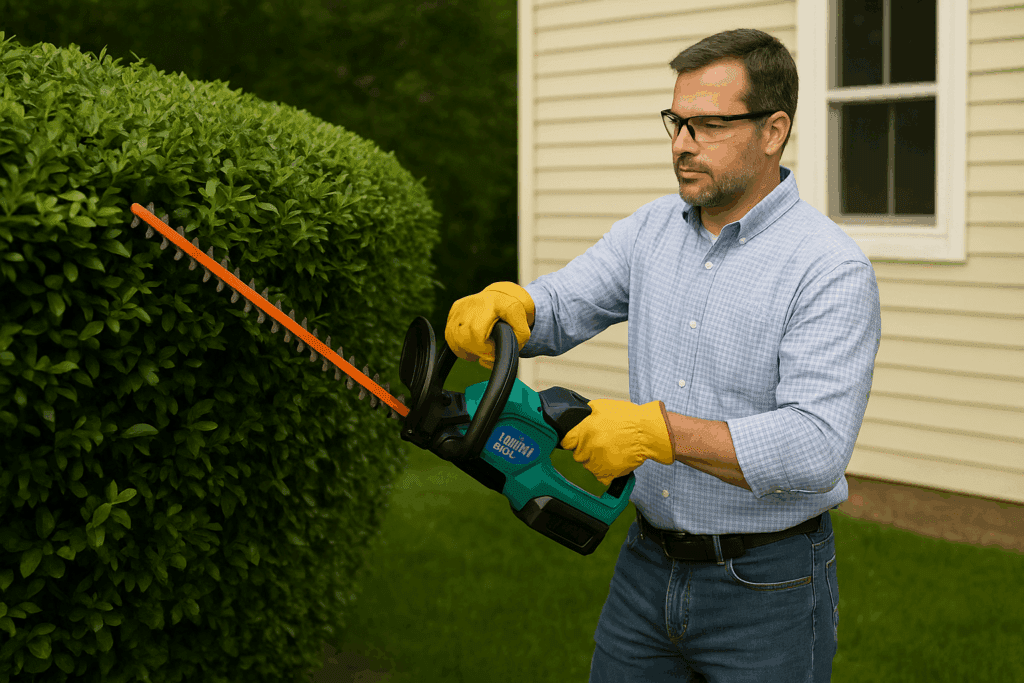
✂️ Battery-Operated Hedge Trimmer: Fast, Clean Cuts for Thick Shrubs
Another tool I highly recommend is the Kobalt 80-volt 26″ hedge trimmer from Lowe’s. As with my other tools, the 80V battery system means I can use the same batteries across all devices, keeping things simple and efficient.
This hedge trimmer’s extra-long 26-inch blade lets me easily reach deep into thick shrubs and hedges without needing to climb or overextend. It delivers a clean, uniform cut—something you just can’t get with loppers. It’s also ideal for shaping, and you can achieve a nice box cut for more formal hedge designs.
I especially prefer this battery-powered version over my older corded trimmer. No more dragging a power cord through flower beds or dealing with the cord getting snagged in shrubs. With the battery version, I move freely and trim faster with much less hassle.
✋ Non-Powered Tree Trimming Tools: Manual Must-Haves for Precision and Control
While battery-powered tools are efficient for big jobs, manual tools still play a vital role in tree and shrub care. They’re quieter, require no charging, and give you greater control for precise cuts, shaping, and detail work.
Here’s a breakdown of the most useful non-powered tree trimming tools, how they’re used, and why they belong in your shed or garden toolbox:
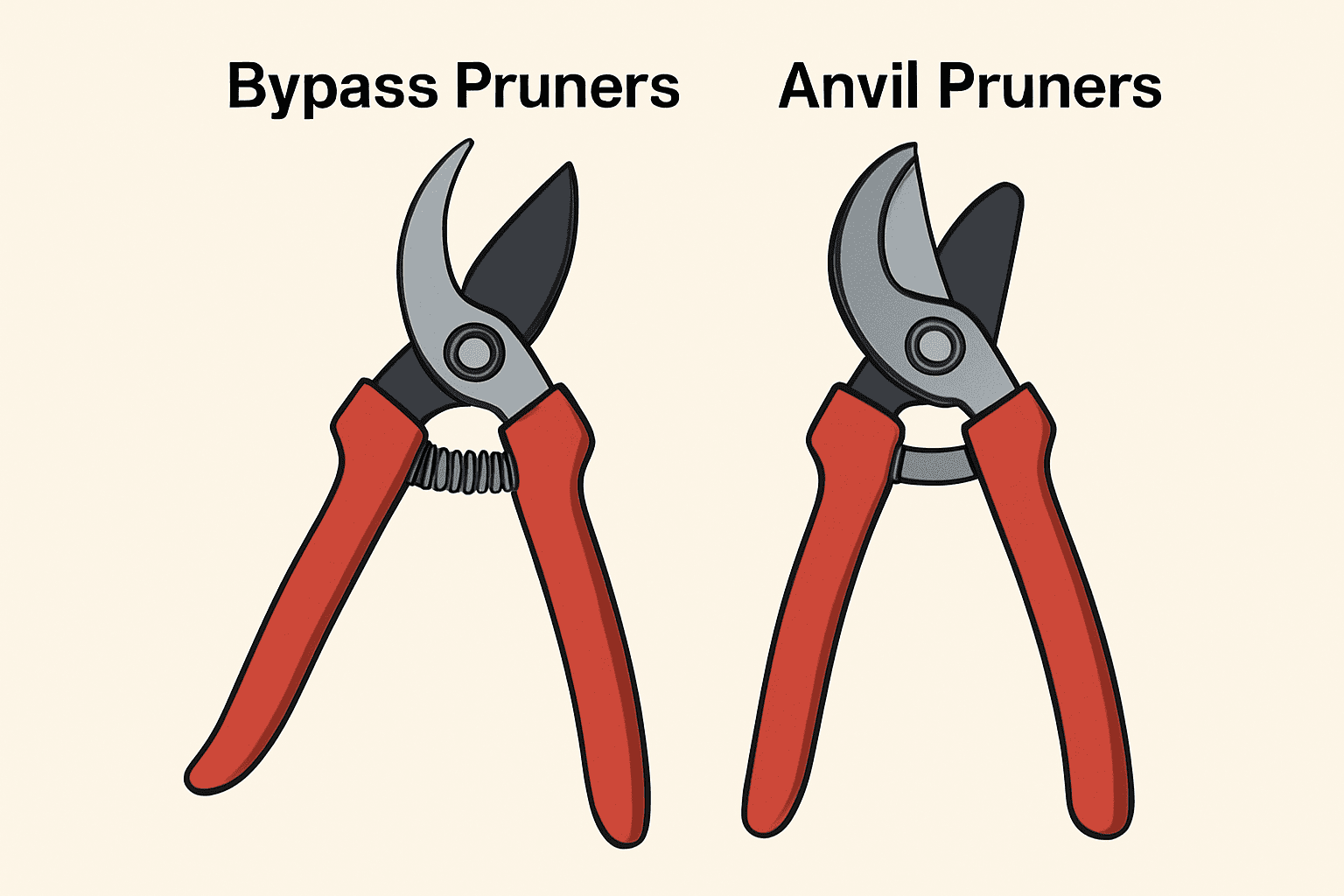
✂️ 1. Hand Pruners (Bypass and Anvil)
Best for: Small branches, dead wood, flowering shrubs, and young growth (up to ¾” thick)
- Bypass pruners use two curved blades that slide past each other for a clean, precise cut—ideal for live stems and healthy growth.
- Anvil pruners have a single straight blade that closes against a flat surface, great for cutting dry or dead stems.
How to use: Position the blade side toward the part of the branch you’re keeping for a clean cut. Always cut just above a bud or branching point to promote healthy regrowth.
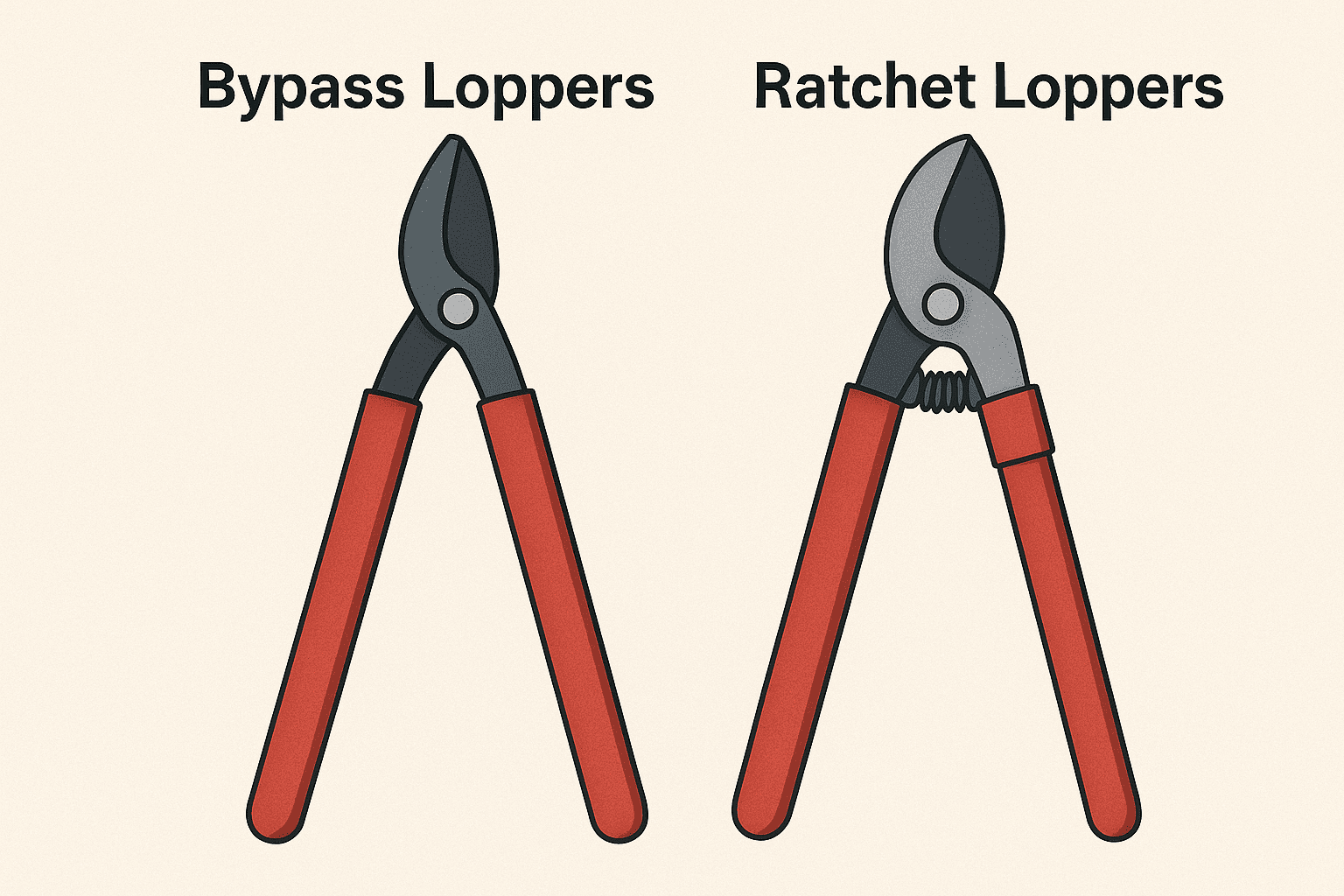
🌿 2. Loppers (Bypass and Ratchet)
Best for: Medium to large branches (up to 2″ thick), fruit trees, and dense shrubbery
- Loppers have long handles for greater leverage, making it easier to cut thicker limbs with less effort.
- Ratchet loppers allow you to cut in stages, which is helpful when tackling tougher wood.
How to use: Place the blade where you want the cut, use both hands, and apply firm, steady pressure. For best results, keep blades clean and sharp.
✂️ 3. Hedge Shears
Best for: Shaping hedges, ornamental shrubs, and creating straight edges
- Manual hedge shears give you control over shape and height, especially for formal designs like box cuts or rounded tops.
How to use: Open and close with steady, even motions across the hedge surface. Trim a little at a time to maintain even lines and prevent overcutting.
🌲 4. Pruning Saws
Best for: Thick branches (larger than 2″), dead limbs, and awkward angles
- Pruning saws come in folding or straight styles with coarse teeth designed for fast cutting on pull strokes.
How to use: Anchor the blade firmly, then pull toward yourself with controlled movements. Avoid sawing too quickly to prevent bouncing or ragged cuts.
🌳 5. Pole Pruners (Manual)
Best for: High branches when you want to avoid using a ladder
- These tools feature a hooked saw or bypass-style blade attached to a long pole, often with a rope or trigger mechanism to activate the cut.
How to use: Position the blade around the branch, then pull the rope or squeeze the trigger to make the cut. Be mindful of falling debris.
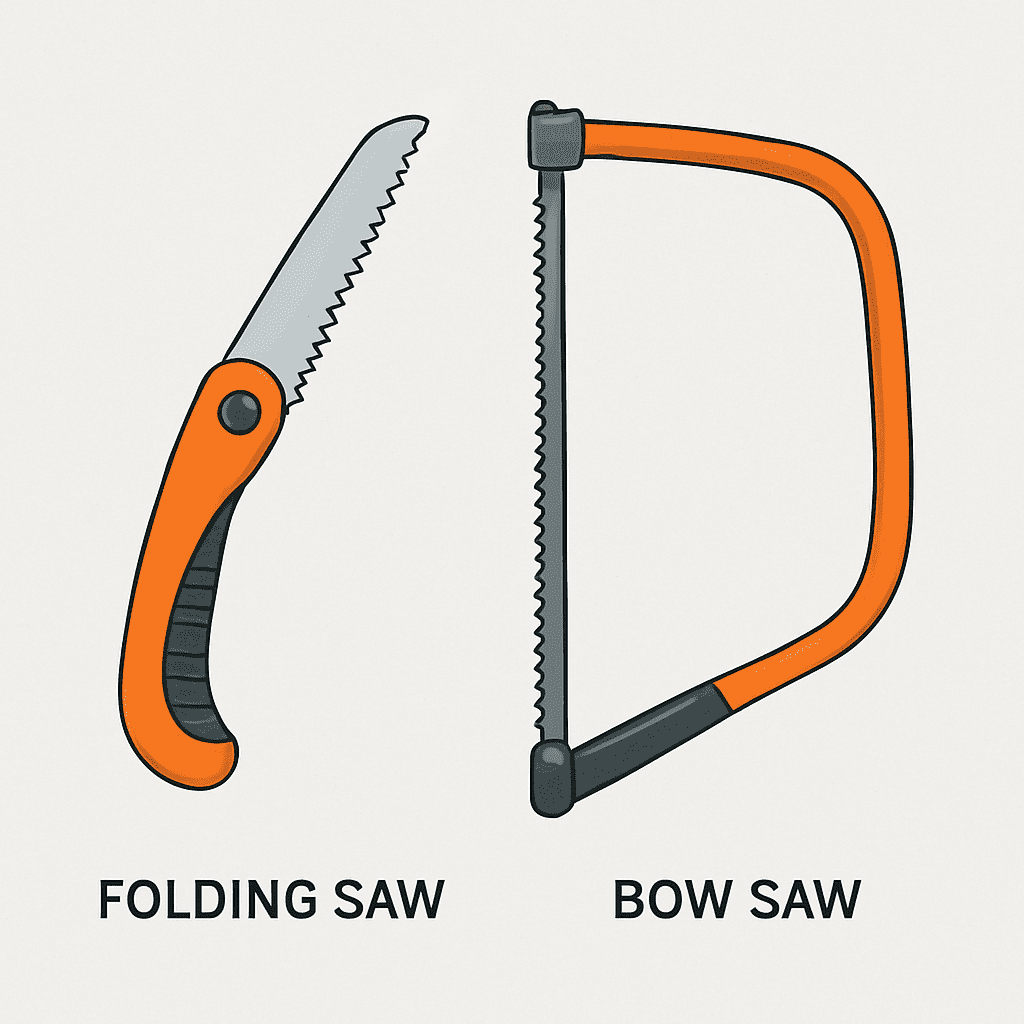
🧤 6. Specialty Shears and Trimmers
Includes:
- Grass shears – for edging the lawn near shrubs
- Topiary shears – for detailed shaping of ornamental bushes
- Folding saws – compact and ideal for branch clean-up or storm damage
- Bow saws – for straight cutting of large fallen limbs or firewood
How to use: Each tool is made for specific tasks—always match the tool to the size of the branch and the angle of your cut.
🧰 Tips for Using Manual Tools Effectively:
- Keep blades sharp – clean cuts heal faster and reduce disease risk.
- Disinfect between trees – especially when pruning diseased branches.
- Use a holster or belt – to keep tools like pruners handy and avoid misplacing them.
- Store dry – wipe blades down after use to prevent rust.
- Use two hands when needed – for control and to reduce strain.
🧰 Recommended Manual Tree Trimming Tools by Brand
✂️ 1. Hand Pruners
Best for: Small branches, flowers, and precision trimming
- Fiskars Bypass Pruner – Excellent for clean, easy cuts on live stems
- Felco F-2 Classic Bypass Pruner – Swiss-made, high-quality blade with replaceable parts
- Corona ClassicCUT Anvil Pruner – Ideal for cutting dry or dead wood
🌿 2. Loppers
Best for: Medium branches (up to 2 inches thick)
- Fiskars PowerGear2 Bypass Lopper – Lightweight with geared leverage for easier cuts
- TABOR TOOLS GG12 Anvil Lopper – Strong for dry branches and woody growth
- Corona SL 4364 Ratchet Lopper – Great for thick branches, requires less force
✂️ 3. Hedge Shears
Best for: Shaping and straight trimming of hedges and shrubs
- Fiskars Power-Lever Hedge Shears – Ergonomic handles and precision-ground blades
- ARS HS-KR1000 Professional Hedge Shears – High-carbon steel blades, lightweight
- Okatsune Precision Hedge Shears – Excellent for detailed, ornamental pruning
🪚 4. Pruning Saws
Best for: Larger branches or awkward cuts
- Fiskars Power Tooth Soft Grip Folding Saw – Great for small to medium branches
- Silky GOMBOY Folding Saw – Premium Japanese pull saw, great for tree work
- Corona RazorTOOTH Folding Saw – Aggressive cutting blade for fast trimming
🔧 5. Bow Saws
Best for: Thick fallen limbs, storm cleanup, or heavy-duty cutting
- Bahco 21″ Bow Saw – Sturdy frame and interchangeable blade
- Fiskars Bow Saw – Comfortable grip with a steel tensioning system
- Truper 21-Inch Bow Saw – Budget-friendly and effective for yard maintenance
🌲 6. Pole Pruners (Manual)
Best for: Reaching high branches safely from the ground
- Fiskars Extendable Pole Saw & Pruner (14′) – Dual-purpose saw and bypass blade with rope pull
- Corona TP 4214 Tree Pruner – Durable fiberglass pole and compound-action cutting
- Jameson LS Series Pole Pruner Kit – Commercial-grade, modular extension system
🧤 7. Specialty Tools & Accessories
Grass Shears:
- Fiskars Shear Ease Grass Shears – Great for trimming around tight spots
Topiary Shears:
- Burgon & Ball Topiary Shears – Designed for detail and shaping
Tool Sharpener:
- Fiskars Blade Sharpener – Keeps pruners and loppers sharp and effective
Work Gloves:
- NoCry Cut Resistant Gloves – Safe for pruning, protect against thorns and blades
- Ironclad General Utility Gloves – Durable, flexible, and well-padded
🔋 Battery-Operated Tree and Shrub Tools by Brand
When it comes to maintaining trees and shrubs, battery-powered tools offer quiet operation, easy handling, and freedom from cords and fuel. Here are some of the top brands and models to consider for various trimming needs.
🌲 Kobalt (80V System)
Kobalt’s 80-volt lineup is ideal for homeowners and pros who want high power without the noise and mess of gas equipment.
- Kobalt 80V 10″ Pole Saw
Perfect for reaching high, thick branches with confidence. The detachable pole sections make it easy to store and extend when needed. - Kobalt 80V 18″ Chainsaw
A heavy-duty battery-powered chainsaw that cuts through large limbs efficiently. Great for storm cleanup and pruning larger trees. - Kobalt 80V 26″ Hedge Trimmer
With its extended blade length, this hedge trimmer is perfect for trimming tall, wide hedges while maintaining clean, uniform cuts.
⚡ DeWalt (20V MAX and 60V FLEXVOLT Systems)
DeWalt tools are known for rugged design and interchangeable batteries across multiple tool types.
- DeWalt 20V MAX XR Pole Saw
Lightweight but powerful enough for most overhead limb work. Great for smaller yards and tight spaces. - DeWalt 60V MAX Chainsaw
Delivers excellent cutting performance, ideal for thick branches and medium-duty use. - DeWalt 20V MAX Hedge Trimmer
A reliable everyday tool for shaping and maintaining small to medium hedges.
🌿 Greenworks (60V & 80V Systems)
Greenworks makes professional-grade battery tools that are especially popular with eco-conscious users.
- Greenworks 80V Brushless Pole Saw
Powerful and efficient for high trimming with less vibration. - Greenworks 80V Brushless Chainsaw
Known for fast cutting and easy maintenance, this chainsaw is great for limb removal and firewood. - Greenworks 60V Hedge Trimmer
Lightweight and maneuverable, perfect for keeping hedges tidy.
🌳 EGO Power+ (56V ARC Lithium Platform)
EGO tools are widely praised for gas-like power and thoughtful ergonomic design.
- EGO 56V Multi-Head Pole Saw System
A modular tool with extendable reach and multiple attachments—perfect for versatile yard care. - EGO 56V 18″ Chainsaw
Designed for serious cutting tasks with reduced noise and no fumes. - EGO 56V Hedge Trimmer
Offers strong cutting performance and longer run time, great for shaping dense shrubs.
🔧 Ryobi (40V System)
Ryobi offers excellent value and accessibility, especially for DIYers and casual users.
- Ryobi 40V Expand-It Pole Saw
Compatible with the Expand-It system—ideal for those looking to build a modular yard tool collection. - Ryobi 40V Brushless Chainsaw
A solid mid-range choice for limb pruning and small tree cutting. - Ryobi 40V 24″ Hedge Trimmer
Wide reach and dual-action blades make hedge shaping fast and easy.
Best Times To Trim Popular Trees
| Tree Type | Best Time to Trim | Notes |
|---|---|---|
| Oak | Late Winter (Jan–Feb) | Avoid trimming in spring to reduce oak wilt risk. |
| Maple | Late Winter to Early Spring | Prune before sap flow begins to avoid heavy bleeding. |
| Pine | Late Winter | Avoid cutting main leader; prune lightly. |
| Crape Myrtle | Late Winter to Early Spring | Trim to shape and remove suckers. |
| Dogwood | Late Winter (Feb) | Avoid fall trimming; risk of disease. |
| Magnolia | Late Winter | Prune lightly; avoid summer trimming. |
| Apple | Late Winter | Trim to encourage fruit production. |
| Pear | Late Winter to Early Spring | Shape and thin for airflow; avoid mid-summer pruning. |
| Redbud | Late Winter (Feb) | Trim after leaf drop but before buds form. |
| Cherry | Late Winter to Early Spring | Early pruning helps prevent disease and encourages blooms. |
Pruning Trees: The How-To
Don’t forget to check out our companion article about trimming trees before your insurance is canceled.
References:
1. International Society of Arboriculture (ISA)
- Email: [email protected]
- Phone: +1 678-367-0981
- Address: 270 Peachtree Street NW, Suite 1900, Atlanta, GA 30303, USA
- Website: www.isa-arbor.com
ISA is a global leader in arborist certification, research, and public education. They offer resources on tree biology, pruning standards, and professional development.
2. Arbor Day Foundation
- General Inquiries Email: [email protected]
- Phone: 1-888-448-7337
- Address: 211 N. 12th Street, Lincoln, NE 68508, USA
- Website: www.arborday.org
The Arbor Day Foundation promotes tree planting and conservation efforts worldwide. They provide educational materials and support community forestry initiatives. It’s Arbor Day. Grow twice the trees.
3. Tree Care Industry Association (TCIA)
- Email: [email protected]
- Phone: 1-800-733-2622
- Address: 670 N Commercial Street, Suite #201, Manchester, NH 03101, USA
- Website: www.tcia.org
TCIA is a trade association that develops safety and education programs, standards of tree care practice, and management information for tree and landscape firms.
4. American Society of Consulting Arborists (ASCA)
- Email: [email protected]
- Phone: +1 443-640-1084
- Address: 2331 Rock Spring Road, Forest Hill, MD 21050, USA
- Website: www.asca-consultants.org
ASCA provides a network for consulting arborists and offers resources for tree risk assessment, tree preservation, and legal consulting. asca-consultants.org
5. Mississippi Forestry Commission – Urban & Community Forestry
- Contact Person: Alex Ballard, Urban & Community Forestry Coordinator
- Email: [email protected]
- Phone: +1 769-237-2934
- Website: https://www.mfc.ms.gov/
The Mississippi Forestry Commission offers guidance on tree care, urban forestry programs, and local arborist referrals.
Bonus Content
✅ How to Spot a Structurally Unstable Tree
1. Leaning Trunk
- A tree that leans more than 15° from vertical may be at risk.
- A sudden lean or recent shift is more concerning than a long-established lean.
2. Cracks or Splits in Trunk or Major Limbs
- Vertical or horizontal cracks may indicate internal decay or stress fractures.
- Check especially where limbs attach to the trunk (“crotches”).
3. Weak Branch Unions
- V-shaped unions are weaker than U-shaped ones.
- Included bark (bark trapped between branches) signals a weak connection likely to split.
4. Dead or Hanging Branches
- Also called “widowmakers,” these can fall without warning.
- Dead wood is brittle and fails under wind or weight.
5. Cavities or Decay
- Hollow trunks or branches, mushrooms or fungal conks growing at the base or on bark, and soft or crumbly wood are signs of decay.
6. Root Problems
- Exposed roots, especially if cut or damaged
- Fungal growth at the base (e.g., honey fungus, Ganoderma)
- Soil heaving or cracking on one side could signal root plate failure
7. Bark Abnormalities
- Missing bark (called “bark sloughing”) or vertical seams could mean internal rot.
- Oozing sap, sawdust-like frass, or boreholes can indicate pest infestation.
8. Canopy Dieback
- Thinning leaves or branches, especially at the top, can indicate structural or root failure.
9. Storm or Lightning Damage
- Lightning can split bark or damage internal wood.
- After storms, look for newly cracked limbs or unstable angles.
🛠️ When to Call a Certified Arborist
If you notice any of these signs—especially in combination—consult an ISA-certified arborist. They can perform a Tree Risk Assessment and recommend mitigation strategies like pruning, cabling, or removal.
RetireCoast Articles
We are offering many articles that connect with this one. You may want to read about Mississippi and trees, plants, and shrubs in our area. Click here.
As a do-it-yourselfer, you probably pay attention to things such as retirement funds. Check out this article.
Our article on the Best Simple ways to Organize Your Financial Life may help you. Click here.
FAQ
🌿 Glossary of Tree & Shrub Trimming Terms
Arborist
A professional trained in the science and art of planting, caring for, and maintaining trees. Certified arborists understand proper pruning techniques, tree health, and safety standards, and are often hired for large or hazardous tree work.
Pruning vs. Trimming
Pruning refers to the selective removal of branches to improve plant health, structure, or growth.
Trimming is usually done to maintain a desired shape or appearance. Pruning is health-focused; trimming is appearance-focused.
Anvil Pruners
Pruning tools with a single straight blade that closes onto a flat surface (the anvil). Ideal for cutting dry or dead branches.
Bow Saw
A saw with a bow-shaped frame and a coarse-toothed blade, used for cutting thick branches or fallen limbs.
Bypass Pruners
Pruners featuring two curved blades that pass by each other, like scissors. Best for live stems and green wood.
Grass Shears
Handheld tools for trimming grass in hard-to-reach spots, such as around garden beds, fences, or trees.
Hedge Shears
Manual tools that look like large scissors, used to trim and shape hedges and bushes evenly.
Loppers
Long-handled pruners that cut branches up to 2 inches thick, offering more leverage than hand pruners.
Pole Pruner
A cutting tool mounted on a long, extendable pole, used to reach and prune high branches safely from the ground.
Pruning Saw
A curved or straight saw with coarse teeth designed to cut through thick or awkwardly placed branches.
Ratchet Pruners
Hand pruners with a ratcheting mechanism that cuts in stages, reducing hand strain on thicker branches.
Safety Goggles
Protective eyewear worn to prevent injuries from flying debris, dust, and branches while trimming.
Topiary Shears
Small shears used for detailed and decorative trimming, especially for shaped ornamental plants.
Weed Whacker (String Trimmer)
A powered tool that uses a fast-spinning string or blade to trim grass and weeds along edges, fences, and uneven terrain.
Enter your email address at the top right and receive notifications of our next article. If you would like us to create a follow-up article on any topic you have read here, let us know.
Discover more from RetireCoast.com
Subscribe to get the latest posts sent to your email.

